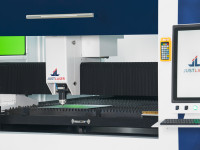What is a UV laser?
Technologie, WirkpriTechnology, operating principle and industrial advantages of "cold" laser markingnzip und industrielle Vorteile der „kalten“ Laserbeschriftung
The demands placed on industrial marking processes are constantly increasing: ever smaller components, more sensitive materials and higher quality standards require technologies that are not only precise, but also gentle and efficient. UV lasers offer a powerful solution in precisely these areas.
The so-called "cold" laser marking with ultraviolet light opens up completely new possibilities in industrial material processing - especially where conventional laser systems reach their limits.
But what exactly is a UV laser? How does this technology work? And why is it becoming increasingly popular in sectors such as electronics manufacturing, medical technology and the packaging industry?
UV laser technology: an introduction
The term "UV laser" describes a laser system that works with ultraviolet light in the 355 nanometer (nm) range - i.e. with a wavelength that is significantly shorter than that of conventional CO₂ or fiber lasers. This short wavelengthensuresa particularly high photon energy, which forms the basis for the unique effect of cold processing.
UV lasers are usually based on a so-called frequency tripled solid-state laser. This means that an infrared laser (e.g. an Nd:YVO₄ with 1064nm) is converted to 355 nm in two steps using non-linear crystals:
- Frequency doubling from 1064 nm to 532 nm (green light)
- Frequency tripling from 1064 nm to 355 nm (UV light)
The result is a stable, highly focusable laser beam with exceptional precision - ideal for marking processes on sensitive or finely structured surfaces.
Cold marking: when light changes the molecules
The key difference to other laser types lies in the operating principle: while CO₂ and fiber lasers generate their markings through thermal effects (e.g. tempering, ablation or melting), the UV laser works primarily on a photochemical basis. This means that the UV radiation has so much energy that it can break molecular bonds directly - without heating the material over a large area.
This so-called cold process offers decisive advantages:
- Minimal heat development: no melting edges, no material deformation, no cracking
- Highest precision: Smallest structures, micro lettering and fine lines with razor-sharp edges
- Smooth surfaces: The processed zone remains clean, even and without elevations or grooves
- Gentle on materials: the structure and function of even temperature-sensitive materials remain unchanged
These properties make UV lasers particularly interesting for applications where thermal influences must be avoided at all costs - such as thin-walled plastics, disposable medical items, microelectronic components or transparent materials such as glass.
Structure of an industrial UV marking laser
A typical UV marking system - such as the JustMark OSU from JustLaser - consists of several functional components that work together seamlessly:
- Laser source: A diode-pumped solid-state laser with frequency conversion to 355 nm
- Galvo scanner: High-precision deflection unit for controlling the laser beam over the workpiece
- F-theta optics: Special lens for uniform imaging of the beam on a defined surface
- Software: User-friendly control software for creating, positioning and managing marking data
Flexibility of use is a key feature of open system solutions such as the JustMark OSU. The systems can be easily integrated into existing production processes or used as stand-alone solutions. Thanks to the open architecture, larger components can also be processed and special automation solutions implemented.
Technical features at a glance
UV lasers are characterized by particularly fine processing properties. The most important technical key figures at a glance:
|
Characteristic
|
Typical value
|
|
Wavelength
|
355 nm (UV spectrum)
|
|
Pulse duration
|
5-15 ns (nanoseconds)
|
|
Beam quality (M²)
|
< 1.5 (near diffraction limit)
|
|
Spot diameter
|
approx. 10-50 µm (depending on lens and setup)
|
|
Marking speed
|
up to 10,000 mm/s (depending on material)
|
|
Material removal
|
photochemical, minimal
|
|
Typical cooling
|
Air-cooled (up to approx. 5-8 W)
|
The combination of short wavelength, high energy density and low thermal influence enables high-precision, permanent and high-contrast markings - on a wide range of materials.
Advantages of the UV laser in industrial practice
Industrial applications benefit from the special properties of a UV laser in several ways. There are enormous advantages, especially in sensitive or safety-relevant areas:
- No thermal changes to the material
- High legibility of codes and lettering, even with micro lettering
- Use on difficult materials such as transparent plastic, glass or ceramics
- Environmentally friendly, as no inks, chemicals or labels are required
- Non-contact, wear-free and low-maintenance
- Seamless integration into automated production lines
Particularly noteworthy is the ability to process complex or multi-layered surfaces. For example, cover layers can be selectively removed to create high-contrast day/night designs (e.g. for control elements in cars) - without damaging the underlying layers.
Where UV lasers are already indispensable today
UV lasers have become indispensable in many industries - especially where maximum precision meets sensitive materials. Typical areas of application are
- Electronics industry: Marking of printed circuit boards, semiconductors, SMD components
- Medical technology: sterile marking of catheters, tubes, surgical instruments
- Automotive industry: control elements in day-night design, sensor labeling
- Packaging industry: direct labeling of plastic packaging, blister packs and ampoules
- Watch & jewelry industry: micro-marking on sensitive surfaces such as glass or gold
Thanks to its versatility in material processing and the quality of the results, the UV laser is now an indispensable tool in modern industrial production.
Conclusion: The future of precise material processing is ultraviolet
UV lasers offer exactly what modern industrial processes need: Precision, material protection and flexibility. The photochemical mode of action opens up new possibilities in marking and microstructuring - especially in applications where thermal processes would lead to a loss of quality.
With the JustMark OSU UV laser, JustLaser provides a system that consistently transfers these advantages into industrial practice - modular, powerful and ideal for all those who place the highest demands on quality and process reliability.



